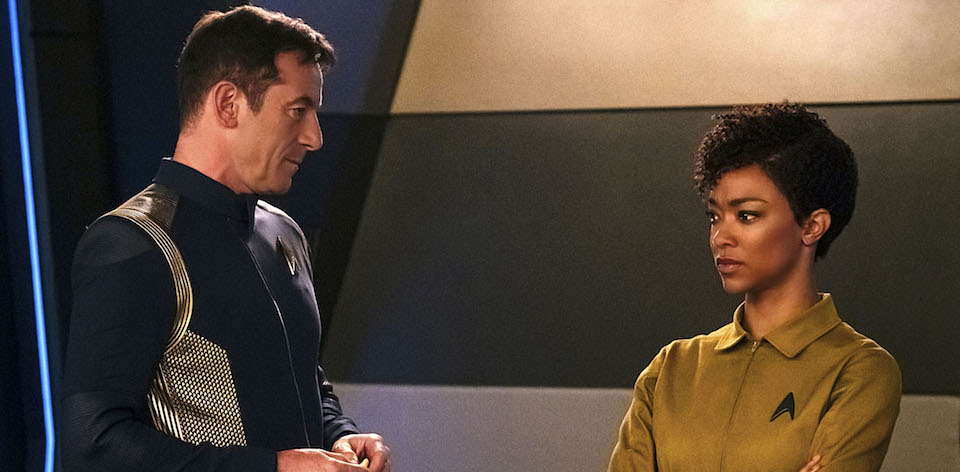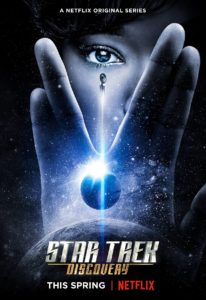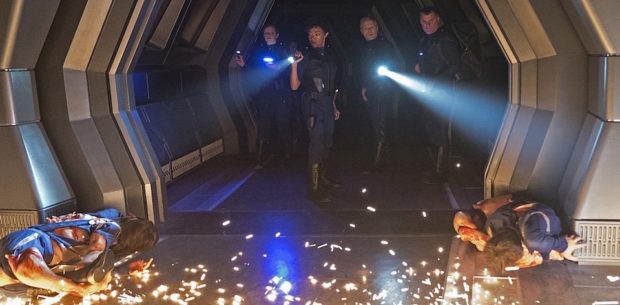With the third episode of STAR TREK: DISCOVERY, the franchise continues to demonstrate its determination to do something different with Star Trek on TV. The ambitious story doesn’t simply break away from the self-contained episodic structure of previous eras, but takes us into some very dark corners in the process.
Boldly skipping ahead six months since the last episode, convicted mutineer Burnham is on a prison ship bound for her life sentence. An emergency results in her vessel being picked up by the newly minted science ship USS Discovery, captained by Michael Lorca (Jason Isaacs) and former colleague Saru (Doug Jones) serving as first officer. Yet not all is what it seems aboard the Discovery.
STAR TREK: DISCOVERY is not the first time Trek has delved into the hidden shadows of the Federation, but rarely has it so deliberately set up entire show structured as a mystery. The war with the Klingons has forced Starfleet to experiment with a Pandora’s box of technology, with potentially Promethean results. Our narrative proximity to Burnham puts us on the back foot as well, so we instantly learn not to take anything at face value.
Which is the other point of difference ‘Context is for Kings’ plays on so well. Not since the disgraced Tom Paris in Voyager has there been a character who has been given outsider standing from the beginning. She’s even more of an unknown entity, and we don’t yet know whether she really wants to get back into Starfleet’s good graces. Isaacs’ captain is mysterious and somewhat suspicious, setting up a hopefully combative dichotomy with Burnham.
Perhaps the biggest cast member introduced in the episode is the ship itself, a novel new design that plays on past but looks to the future. Indeed, there’s only a handful of things that are yet to be fully realised. Mary Wiseman’s presence as the grating cadet Sylvia Tilly, for example, makes us yearn for an imminent red shirt moment. Then there’s the questions around what they find on sister ship the USS Glenn, delving deep in horror territory, complete with a monster and some graphic body horror. This is something we suspect will come back in spades later.
Despite the heavy presence of director Akiva Goldsman, whose touch of death has marked everything from Batman & Robin to The Dark Tower, this episode further shows what Trek can be when commits to long-form narrative. This is not a show that will wrap everything up in a neat bow at the end of every episode, nor will we necessarily want it to. So even without an overt mission of exploration, we are truly watching Trek journey into the unknown.
[stextbox id=”grey” bgcolor=”F2F2F2″ mleft=”5″ mright=”5″ image=”null”]2017 | US | CREATORS: Bryan Fuller, Alex Kurtzman | DIRECTOR: Akiva Goldsman | WRITERS: Bryan Fuller, Gretchen J. Berg, Aaron Harberts (story), Gretchen J. Berg, Aaron Harberts, Craig Sweeney (Teleplay) | CAST: Sonequa Martin-Green, Doug Jones, Rekha Sharma, Jason Isaacs | DISTRIBUTOR: Netflix (AUS), CBS All Access (US) [/stextbox]






